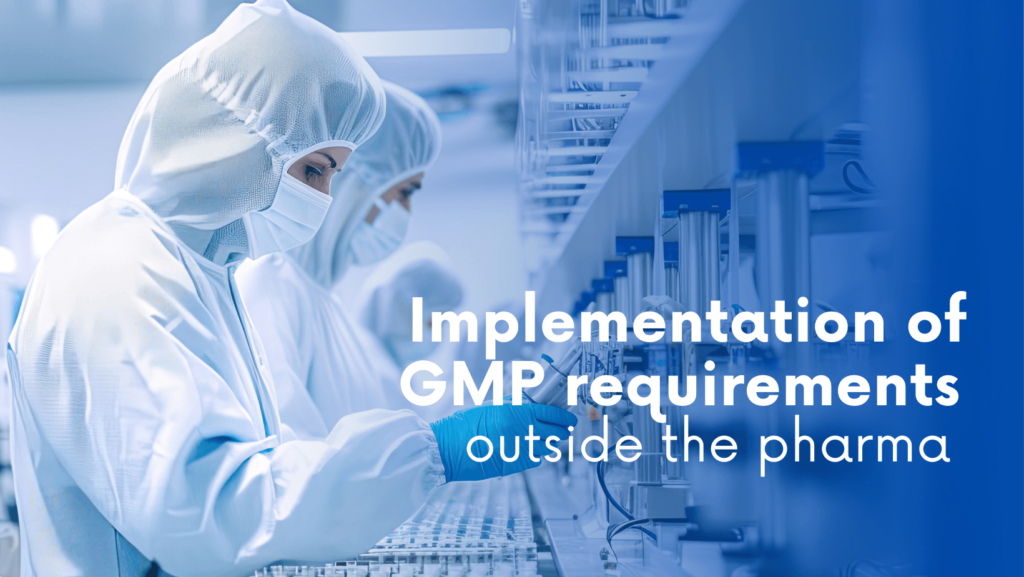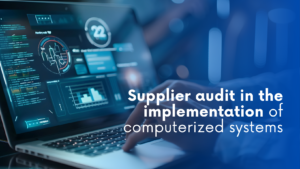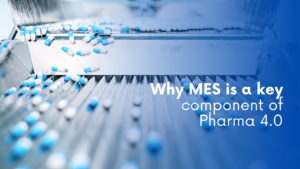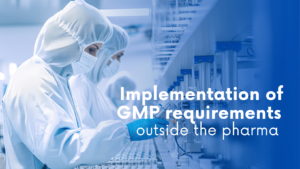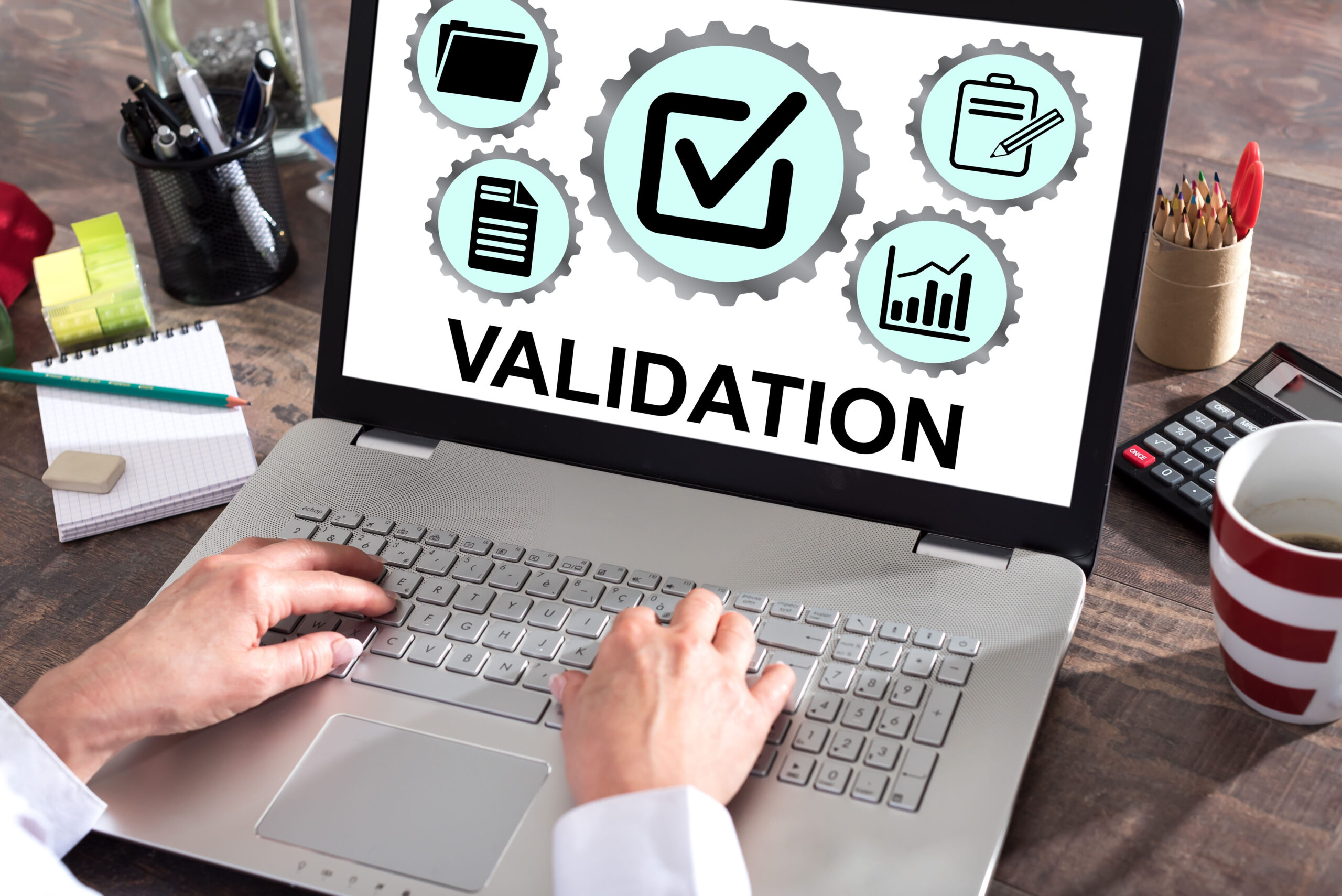The implementation and maintenance of the GMP system is a highly challenging, time-consuming, often tedious, and demanding task. It is so burdensome that most individuals working within this system would respond negatively to the question of whether to implement even elements of GMP if it is not directly required by law. The topic is very complex, and it is not possible to describe in detail step by step a plan for implementing GMP from A to Z. However, this text presents a framework for the process of implementing GMP elements into a non-pharmaceutical industry. It is not another guide outlining project management methods or describing the administrative path for GMP certification. The described issues, or challenges, can be a source of encouragement for overburdened project team members, bringing them closer to a “GMP catharsis” – for example, realizing “it’s not just us facing this problem” or “it’s good to know that others are also dealing with this issue – we are not unique in these difficulties.”
There are situations when, for various reasons, companies intend to introduce GMP elements into their quality system. This typically applies to companies in the medical device industry, those dealing with products falling under the In Vitro Diagnostic Regulation (IVDR), but it can also involve transportation companies, manufacturers of excipients, IT industry, garment laundries for cleanrooms, and other service providers to the pharmaceutical industry. The need for these changes may arise from new regulations governing industry standards, contracts with pharmaceutical client companies, or the desire to elevate standards to enhance the attractiveness of the services provided.
An ideal example of a GMP element implemented by non-pharmaceutical companies is qualification and validation. For instance, in the IVDR regulation, Annex II – Technical Documentation, point 6 describes the elements of the system that should undergo validation. However, there is no information on how, to what extent, and what specifically should be validated. Another example is the GDP regulation, which includes the following provision:
“Wholesale distributors should identify what key equipment qualification and/or key process validation is necessary to ensure correct installation and operation. The scope and extent of such qualification and/or validation activities (such as storage, pick and pack processes) should be determined using a documented risk assessment approach.”
Another example is shifting the responsibility for validation to suppliers within a quality agreement with the manufacturer of medicinal products.

However, are the validation requirements from Annex 15 of GMP mandatory for non-pharmaceutical companies? The answer is both obvious and perhaps surprising. These requirements are not mandatory, but no other legal act describes the qualification and validation process in such a detailed manner. Moreover, an auditor verifying validation will expect a similar process, complete documentation, and approach as in the pharmaceutical industry, such as having at least IQ, OQ, and PQ for qualification, conducting risk analysis, and concluding with a report. Why invent alternative meanings for validation when one can leverage the experience and knowledge of the pharmaceutical industry? This seems to be the safest approach, minimizing the risk of questioning validation work and the need to repeat the process on a different and usually larger scale. However, to conduct a process validation (e.g., manufacturing), many preliminary conditions must be ensured, such as equipment qualification, cleaning validation, analytical method validation, room qualification, IT systems validation, and more. To accomplish all this, prerequisites for the above processes must be met. The sequence of performing qualification and validation work cannot be arbitrary or incorrect. The lack of a proper approach to the subject can prolong the entire process and ultimately lead to failure.
How, then, to plan validation when the company lacks proper procedures, human resources with knowledge of both validation and the ongoing process, equipment is not qualified, the Quality Department does not operate on validated methods, and the production area is far from resembling the cleanroom image we see in industry advertisements? If the work culture and the documentation of processes in the company are also far from ideal, and the creative team highly values the opportunity to improve the process without making formal changes to technical instructions? Again, the answer is simple, but the execution of tasks will not be as straightforward. It is necessary to define the goal (who, when, and what needs to be done), specify the needs, plan the work, and then execute the plan.
What is the goal?
It is essential to define the goal – specifying when each task should be completed. At this stage, there should be a clear idea of who will be responsible for the implementation work. This is the moment to internally and in collaboration with external experts, verify the alignment of the system, infrastructure, procedures, and processes with the requirements, including GMP. It is advisable to have an external, independent GMP auditor conduct an audit to assess compliance with the specified requirements. This allows for a fresh perspective on the processes. The notion that someone from outside will magically introduce GMP or GMP elements without the involvement of the company’s employees is wishful thinking. Without a motivated, aware, and responsive project team, the project cannot succeed within the intended timeframe and budget.
A good step would be to identify a team within the company – at least one person from key areas. This personnel should undergo basic GMP training and read the relevant GMP section that concerns them at least 10 times. These team members will soon face numerous challenges and decisions related to GMP, so it is crucial to relieve them of any non-critical duties they have held so far. The possibility of adding leadership responsibilities in the GMP implementation area while simultaneously managing their existing duties without affecting timeliness and quality for both should also be assessed as unlikely. The outcomes of their work will influence the functioning of GMP for several years, and, therefore, directly impact the processes within the company. Neglect and mistakes at this stage will require even more resources to rectify and ensure smooth functioning. It can also be assumed that sooner rather than later, this staff will be under significant pressure, and the time to complete all tasks may not fit within a standard eight-hour workday.
With the team identified and a list of GMP non-compliances in hand, a decision must be made on whether the company’s human resources are sufficient for implementing the system elements or if external firms should be engaged. Regardless of the decision, a project manager should be appointed to lead the development of the work schedule with the project team and manage the activities throughout the entire process.
Further considerations will describe the GMP implementation process leading to manufacturing validation. This is a topic I am professionally familiar with. To provide a detailed description, it is necessary to narrow the perspective to specific details.
The implementation of GMP elements has been divided into 5 stages marked with Roman numerals from I to V. These stages are arranged chronologically and should follow each other. Of course, transitional stages are allowed, where one stage has not yet fully concluded, but the next one has already begun.

Phase I: Preparatory Phase
1. Determination of the main goal with precision – e.g., validation of the manufacturing of specific end products.
2. Specification of preliminary requirements for manufacturing validation, such as qualified production and laboratory equipment, qualified facilities and auxiliary systems including media like Purified Water (PW), Water for Injection (WFI), and/or Compressed Air (CA), qualified IT infrastructure, and previously conducted validation of analytical methods, transportation, cleaning, IT systems, as well as other qualification tasks like mapping warehouse spaces. The criticality analysis is helpful in defining these topics, segregating objects, equipment, and processes into non-critical and critical categories, indicating the need for further qualification or validation work.
3. Completion of the system documentation – first of all, the required procedures, then the required instructions for the identified critical areas and devices mentioned above, for example, for a production device, at least the user manual, cleaning instructions, maintenance and repair instructions, and calibration of critical Measuring Control Equipment (the criticality of them are also determined using appropriate tools/risk analysis) installed in the device. Other necessary documents for development are IT system specifications, specifications of input materials, semi-finished products, and finished products.
4. The particular difficulty may arise in developing instructions for production processes that will later undergo the validation process – for example, cleaning of critical devices (cleaning validation), manufacturing process (process validation), or packaging (packaging validation) with consideration for serialization and aggregation. To do this as effectively as possible, it is necessary to combine the work and skills of at least:
- Individuals familiar with the process. This is the final moment to solidify the rules of conducting the process, parameterize it, determine critical process parameters (CPP), and establish operational ranges. These will undergo verification during the OQ/PQ qualification stage and subsequently during the process validation. For this purpose, it is usually the best choice to involve lower-level management such as team leaders, supervisors.
- Individuals familiar with the principles, legal requirements, and common GMP trends for developing documentation. An example could be an Equipment Hygiene Plan, describing the cleaning process step by step to be clear and comprehensible for the staff. The document should outline critical cleaning stages and necessitate the creation of records confirming adherence to the cleaning instructions. Another example is the development of new batch manufacturing instructions, along with batch report templates according to the requirements outlined in Chapter 4 DOCUMENTATION of the GMP regulation.
5. An incredibly important stage in the creation of crucial procedural instructions is their testing by production employees, who will be given sufficient time to familiarize themselves with the developed document. No one, like them, knows the processes inside out and will catch errors in the process description, lack of chronological order of activities, logical errors, duplicate documentation, issues under slightly different manufacturing conditions, or excessive administrative burden during ongoing production (e.g., waiting time for laboratory approval to proceed to the next stage). A single live test by a working shift on a GMP document developed by experts can bring a tremendous amount of positive changes.
6. Calibration of critical Measuring Control Equipment sensors (both in production and in the warehouse, laboratory, and other critical areas).
7. Determining the need for the purchase of additional equipment and addressing their qualification if required.
8. Conducting the necessary modernization works in the manufacturing area.
II Implementation of New Procedures
The developed procedures, instructions, and other system documents should be signed and implemented into the existing quality system. The relevant personnel should undergo training, and these training sessions should be documented. New responsibilities and authorizations resulting from the procedures should be assigned to employees.
III Qualification and Validation Planning
Concluding or being in the final stages of the above tasks, it is essential to determine how critical objects, devices, and processes (identified, for example, through criticality analysis) will be qualified and validated. This work should be carried out using Quality Risk Management methods – for example, employing tools such as FMEA, which allows presenting risk in numerical form, facilitating the prioritization of risks. This is a challenging but creative task that ultimately brings satisfaction, especially upon completion, involving a multidisciplinary team. With this knowledge, it is possible to develop the VP (Validation Plan), smaller qualification plans (e.g., equipment qualification plan, process validation plan, and others). This is a crucial milestone because:
1. It is possible to estimate quite precisely how much time is needed for the completion of further qualification and validation activities. The previously defined preliminary conditions are slowly being finalized, and the scope of required tests is known.
2. The project team is being made aware that the time for enjoyable and relatively calm work is coming to an end. Despite the fact that at this stage it may seem that the project team’s workload is around 150%, the period leading up to the qualification and validation phase may be remembered with nostalgia for a subjectively easier stage.
3. It should be assumed that there is no longer room for the so-called “We need to sit down and think it over calmly,” meaning postponing it to an indefinite time. Instead, in teams of responsible experts, decisions must be made swiftly to prevent one project mode from bringing everything to a standstill.

IV Qualification and validation
1. For the purposes of qualification and validation processes, a larger team should be allocated – whether from the investor’s resources, equipment suppliers, or commercially specialized firms conducting qualifications and validations. Where possible, the most convenient, fastest, and often the most cost-effective option is to purchase equipment along with qualification services from the supplier (e.g., for laboratory equipment). The multitude of tests, interconnections between qualifications and validations, deviations—all conducted not in an isolated environment but within the dynamic operation of the facility—will require a significant amount of risk paper, pens, coffee, and friction blisters on the hands of those doing the writing.
2. Qualification activities should be carried out according to the qualification plans within the specified timelines outlined in the VP. In the case of objectively justified changes and delays, it is crucial to continuously assess how they impact the qualification process. The sequence of activities is highly significant; for instance, first qualifying laboratory equipment and then validating the analytical method performed on the equipment. It’s important to remember that analyses should not be conducted on unqualified equipment.
3. Gathering numerous qualification and validation activities around the same time has a downside – often the same employees are involved in multiple projects simultaneously. On the positive side, it’s easy to align equipment PQ with validations, reducing the overall time and effort. The concentration of these activities at the same time also creates a unique atmosphere of focus and understanding, especially among employees not typically involved in qualifications and validations.
4. The conclusion of qualification and validation should be documented in reports. Traceability matrices (TM – Traceability Matrix) can prove to be useful tools, verifying whether all identified risks and requirements from the User Requirement Specification (URS) have been adequately addressed through appropriate actions, such as validation tests.
5. The conclusion of the qualification process is usually associated with addressing and closing the deviations that arose during the work when there was no room for their resolution.
6. If some of the validation processes cannot be completed on time due to the impossibility of executing test steps (e.g., transportation validation, cleaning validation), it is necessary to revise the implementation deadlines in the VP and promptly conclude the tests, taking into account factors such as seasonal temperature changes in relation to transport validation.
V Maintenance Phase of the System
1. This phase may seem easy and enjoyable, but it doesn’t necessarily have to be. It typically involves either concluding collaboration with a consulting/advisory company or reallocating human resources from GMP processes to other tasks within the manufacturer’s domain.
2. This is a good time to implement changes in the GMP system proposed in the qualification and validation reports.
3. At this stage, it is also worth considering a new division of GMP responsibilities within the manufacturing team. This is possible because the team has already been assessed and made aware of the energy required for various activities.
4. At this stage, it is advisable to conduct an internal audit that could independently verify the completeness of the completed work and assess the adherence of manufacturing employees to the new procedures and instructions.
5. Upon the completion of the above tasks, the manufacturing facility can be deemed ready for customer audits or inspections by government authorities.
The implementation of GMP elements into the quality system of a company operating in an industry other than pharmaceuticals is possible. However, it typically requires much more effort than initially perceived. It is advisable to carefully consider such a decision with individuals familiar with similar projects who can define the scope of necessary work and identify potential major risks for this plan. From a business perspective, it is crucial to specify a clear objective – what, when, and to what extent. Utilizing the support of companies offering GMP quality services, especially in the stage of defining the scope of work, audits, and during the implementation of the qualification and validation system, is valuable. Flexibility in consulting services is crucial, as the manufacturer may need different quantities and qualities of resources during the planning of qualification and validation, the hot phase of validation testing, or, for example, when closing deviations. Collaborating with external experts can introduce an appropriate standard and work culture in the GMP area. Joint problem-solving by the area employee and GMP expert is the most valuable form of training, which cannot be replicated even in the best open lectures or workshop-style training.
Grzegorz Suwała
Senior Validation Specialist
